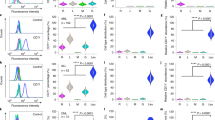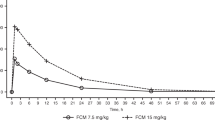Abstract
Acute myeloid leukaemia is a fatal disease for most patients. We have found that ferumoxytol (Feraheme), an FDA-approved iron oxide nanoparticle for iron deficiency treatment, demonstrates an anti-leukaemia effect in vitro and in vivo. Using leukaemia cell lines and primary acute myeloid leukaemia patient samples, we show that low expression of the iron exporter ferroportin results in a susceptibility of these cells via an increase in intracellular iron from ferumoxytol. The reactive oxygen species produced by free ferrous iron lead to increased oxidative stress and cell death. Ferumoxytol treatment results in a significant reduction of disease burden in a murine leukaemia model and patient-derived xenotransplants bearing leukaemia cells with low ferroportin expression. Our findings show how a clinical nanoparticle previously considered largely biologically inert could be rapidly incorporated into clinical trials for patients with leukaemia with low ferroportin levels.
This is a preview of subscription content, access via your institution
Access options
Access Nature and 54 other Nature Portfolio journals
Get Nature+, our best-value online-access subscription
$29.99 / 30 days
cancel any time
Subscribe to this journal
Receive 12 print issues and online access
$259.00 per year
only $21.58 per issue
Buy this article
- Purchase on Springer Link
- Instant access to full article PDF
Prices may be subject to local taxes which are calculated during checkout




Similar content being viewed by others
Data availability
The data that support the plots within this paper and other findings of this study are available from the corresponding author upon reasonable request.
References
Almeida, A. M. & Ramos, F. Acute myeloid leukemia in the older adults. Leuk. Res. Rep. 6, 1–7 (2016).
Cancer Facts & Figures 2018 (American Cancer Society, 2018); https://www.cancer.org/content/dam/cancer-org/research/cancer-facts-and-statistics/annual-cancer-facts-and-figures/2018/cancer-facts-and-figures-2018.pdf
Gashaw, I., Ellinghaus, P., Sommer, A. & Asadullah, K. What makes a good drug target? Drug Discov. Today 17, S24–S30 (2012).
Zong, H. et al. A hyperactive signalosome in acute myeloid leukemia drives addiction to a tumor-specific Hsp90 species. Cell Rep. 13, 2159–2173 (2015).
Lapidot, T. et al. A cell initiating human acute myeloid leukaemia after transplantation into SCID mice. Nature 367, 645–648 (1994).
Krug, U., Buchner, T., Berdel, W. E. & Muller-Tidow, C. The treatment of elderly patients with acute myeloid leukemia. Dtsch. Ärztebl. Int. 108, 863–870 (2011).
Guzman, M. L. et al. The sesquiterpene lactone parthenolide induces apoptosis of human acute myelogenous leukemia stem and progenitor cells. Blood 105, 4163–4169 (2005).
Wen, J., You, K. R., Lee, S. Y., Song, C. H. & Kim, D. G. Oxidative stress-mediated apoptosis. The anticancer effect of the sesquiterpene lactone parthenolide. J. Biol. Chem. 277, 38954–38964 (2002).
Gao, L. et al. Intrinsic peroxidase-like activity of ferromagnetic nanoparticles. Nat. Nanotechnol. 2, 577–583 (2007).
Pinnix, Z. K. et al. Ferroportin and iron regulation in breast cancer progression and prognosis. Sci. Transl. Med. 2, 43ra56 (2010).
Deng, Z., Manz, D. H., Torti, S. & Torti, F. M. Effects of ferroportin-mediated iron depletion in cells representative of different histological subtypes of prostate cancer. Antioxid. Redox Signal 30, https://doi.org/10.1089/ars.2017.7023 (2017).
Nemeth, E. et al. Hepcidin regulates cellular iron efflux by binding to ferroportin and inducing its internalization. Science 306, 2090–2093 (2004).
Torti, S. V. & Torti, F. M. Iron and cancer: more ore to be mined. Nat. Rev. Cancer 13, 342–355 (2013).
Basuli, D. et al. Iron addiction: a novel therapeutic target in ovarian cancer. Oncogene 36, 4089–4099 (2017).
Gu, Z. et al. Decreased ferroportin promotes myeloma cell growth and osteoclast differentiation. Cancer Res. 75, 2211–2221 (2015).
Strauss, W. E., Dahl, N. V., Li, Z., Lau, G. & Allen, L. F. Ferumoxytol versus iron sucrose treatment: a post-hoc analysis of randomized controlled trials in patients with varying renal function and iron deficiency anemia. BMC Hematol. 16, 20 (2016).
Birben, E., Sahiner, U. M., Sackesen, C., Erzurum, S. & Kalayci, O. Oxidative stress and antioxidant defense. World Allergy Organ. J 5, 9–19 (2012).
Ashton, J. M. et al. Gene sets identified with oncogene cooperativity analysis regulate in vivo growth and survival of leukemia stem cells. Cell Stem Cell 11, 359–372 (2012).
Neering, S. J. et al. Leukemia stem cells in a genetically defined murine model of blast-crisis CML. Blood 110, 2578–2585 (2007).
Cerami, E. et al. The cBio cancer genomics portal: an open platform for exploring multidimensional cancer genomics data. Cancer Discov. 2, 401–404 (2012).
Pei, S. et al. Rational design of a parthenolide-based drug regimen that selectively eradicates acute myelogenous leukemia stem cells. J. Biol. Chem. 291, 21984–22000 (2016).
Tesfay, L. et al. Hepcidin regulation in prostate and its disruption in prostate cancer. Cancer Res. 75, 2254–2263 (2015).
Cairns, R. A., Harris, I. S. & Mak, T. W. Regulation of cancer cell metabolism. Nat. Rev. Cancer 11, 85–95 (2011).
Prousek, J. Fenton chemistry in biology and medicine. Pure Appl. Chem. 79, 2325–2338 (2007).
Raynal, I. et al. Macrophage endocytosis of superparamagnetic iron oxide nanoparticles: mechanisms and comparison of ferumoxides and ferumoxtran-10. Invest. Radiol. 39, 56–63 (2004).
Boros, E., Bowen, A. M., Josephson, L., Vasdev, N. & Holland, J. P. Chelate-free metal ion binding and heat-induced radiolabeling of iron oxide nanoparticles. Chem. Sci. 6, 225–236 (2015).
Wadhwa, J. et al. Factors affecting duration of survival after onset of blastic transformation of chronic myeloid leukemia. Blood 99, 2304–2309 (2002).
Zanganeh, S. et al. Iron oxide nanoparticles inhibit tumour growth by inducing pro-inflammatory macrophage polarization in tumour tissues. Nat. Nanotechnol. 11, 986–994 (2016).
Auerbach, M., Chertow, G. M. & Rosner, M. Ferumoxytol for the treatment of iron deficiency anemia. Exp. Rev. Hematol. 11, 829–834 (2018).
Yuan, H. et al. Heat-induced radiolabeling and fluorescence labeling of Feraheme nanoparticles for PET/SPECT imaging and flow cytometry. Nat. Protoc. 13, 392–412 (2018).
Ye, H. et al. Leukemic Stem Cells Evade Chemotherapy by Metabolic Adaptation to an Adipose Tissue Niche. Cell Stem Cell 19, 23–37 (2016).
Acknowledgements
This work was supported by the following grants: National Institutes of Health (NIH) R01CA218615 and R01CA215700 (to J.G.), P30 CA08748 (to C. Thompson, MSKCC) and R01CA172546 and R01CA102031 (to M.L.G.), an ALSF for Childhood Cancer Research award (to C.K.), Mr William H. and Mrs Alice Goodwin and the Commonwealth Foundation for Cancer Research and The Center for Experimental Therapeutics of Memorial Sloan Kettering Cancer Center (to J.G. as co-PI). J.G.’s primary affiliation is the Molecular Pharmacology program of Memorial Sloan Kettering Cancer Center with a secondary appointment at its Radiology Department. He also has an appointment at the Pharmacology Program at Weil Cornell Medical College. Affiliations are listed in order of the authors.
Author information
Authors and Affiliations
Contributions
V.T.-A., E.C.P., H.Z., C.K., J.G. and M.L.G. devised and conducted experiments and wrote the manuscript. A.L.-M. and M.O.R. performed experiments. M.W.B. and G.J.R. discussed the data and wrote the manuscript. V.L. conducted injections.
Corresponding authors
Ethics declarations
Competing interests
J.G., C.K., H.Z. and M.L.G. have filed pending US patent application 15/759,161 and pending EU application 16,845,094.8 around the therapeutic use of ferumoxytol. C.K. is currently an employee of Alnylam Pharmaceuticals.
Additional information
Journal peer review information: Nature Nanotechnology thanks Kamil Kranc and other anonymous reviewer(s) for their contribution to the peer review of this work.
Publisher’s note: Springer Nature remains neutral with regard to jurisdictional claims in published maps and institutional affiliations.
Supplementary information
Supplementary Information
Supplementary Tables 1–4, Supplementary Figures 1–17
Rights and permissions
About this article
Cite this article
Trujillo-Alonso, V., Pratt, E.C., Zong, H. et al. FDA-approved ferumoxytol displays anti-leukaemia efficacy against cells with low ferroportin levels. Nat. Nanotechnol. 14, 616–622 (2019). https://doi.org/10.1038/s41565-019-0406-1
Received:
Accepted:
Published:
Issue Date:
DOI: https://doi.org/10.1038/s41565-019-0406-1
This article is cited by
-
Targeting ferroptosis for leukemia therapy: exploring novel strategies from its mechanisms and role in leukemia based on nanotechnology
European Journal of Medical Research (2024)
-
The crosstalk between exosomes and ferroptosis: a review
Cell Death Discovery (2024)
-
Ferritinophagy induced ferroptosis in the management of cancer
Cellular Oncology (2024)
-
BRAF(V600E) mutation together with loss of Trp53 or pTEN drives the origination of hairy cell leukemia from B-lymphocytes
Molecular Cancer (2023)
-
Mackinawite nanozymes as reactive oxygen species scavengers for acute kidney injury alleviation
Journal of Nanobiotechnology (2023)



